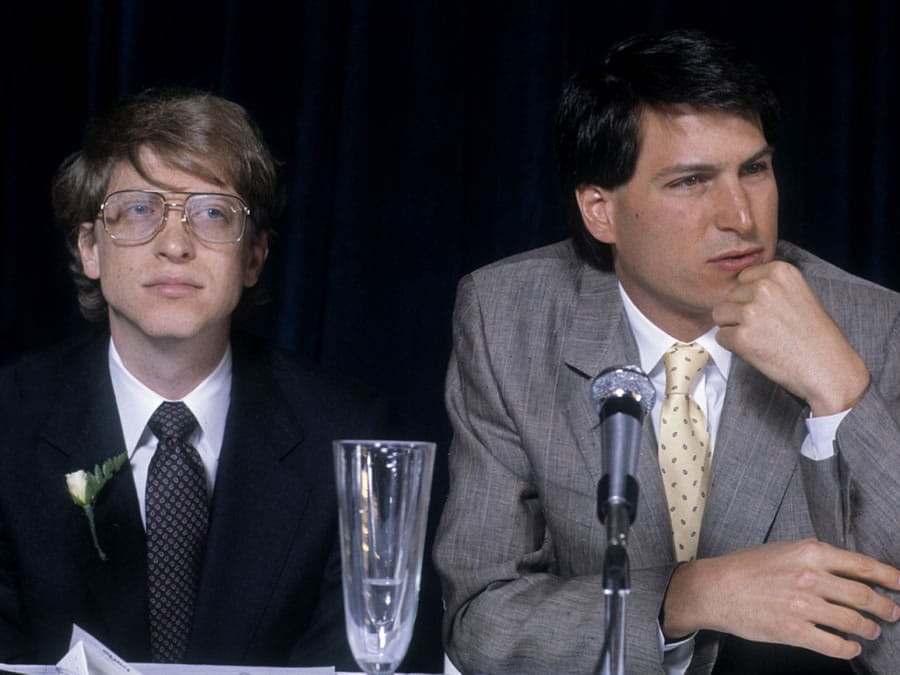
Bill Gates vs. Steve Jobs essay
Bill Gates and Steve Jobs are the two personalities who have changed the world. Having founded their companies almost simultaneously, both of them have become the leaders in their fields, provided the world with revolutionary opportunities and made billions on their creations.
Bill Gates is one of the founders and the largest shareholder of Microsoft Corporation, the world leader in the production of software. In his turn, Steve Jobs as the co-founder of Apple Corporation was fascinated by the idea of creating an innovative personal computer, modern, accessible and popular among consumers. Therefore, at the dawn of companies’ existence, their work logically intertwined with the history of IBM development. By the time when IBM decided to enter the PC market in 1980, Gates’ small and yet unstable company had already earned a reputation of one of the leading experts on microprocessor programming in the United States, having experience in creating software for Commodore, RadioShack, as well as Apple’s first personal computer wearing a plastic body Apple-2 (Arthur 49-53). This reputation served Gates as a pass to IBM, which in October 1980 concluded with Microsoft a contract for designing MS-DOS operating system.
In the end, MS-DOS, created and patented by Gates, became the industry standard for a PC operating system, and by 1993, 90% of world’s computers were using MS-DOS, regardless of whether they were produced by IBM or other companies on the principle of open architecture (Arthur 57). In its turn, similarly to IBM, Apple started to suffer significant losses due the difficulty to sell computers of the satiated market. Besides, Apple’s confrontation with the fledgling company of Gates led to Apple’s loss of exclusive rights to its own designed interface (Arthur 61). The subsequent innovation by Gates was the operating system Windows 3.0, which could work on any PC available in the market. The strategy of company’s openness resulted in an extremely difficult times for Apple and their Mac PC (Hedgebeth 287). At that time, Apple’s confidence in the strengths of Mac OS prevented them from feeling the current nature of the market. In contrast to Microsoft, Apple was leading the strategy of closeness and elitism, as soon as Apple declared the private property on Mac OS and decided to offer it only in conjunction with its own accurately designed devices and charge a premium price for that.
The strategy of Apple in claiming a different market segment than Microsoft factually paid off. In the next decades, the genius of Steve Jobs helped introduce significant technological breakthroughs like PowerMac G3, PowerMac G4, iBook and iMac, Apple Store opening and iTunes application launch, which contributed to company’s regaining of its positions on the market (Arthur 115-20). Due to Jobs personal involvement in each of the developments, Apple has become the gold standard of the modern world of engineering and technology. The innovative design, user interface, advanced and diversified ecosystem are still the success factors of the company in any segment where it operates. Today no one can argue with the statement that this brilliant escape from crisis situation was mainly due to Steve Jobs, who took control over the company when it was on the verge of bankruptcy, and then made it reach the heights.
Meanwhile, Microsoft allowed many low-cost technology companies to install its operating system, and took the leading position due to network externalities mainly. People used Windows, because others also used Windows, and the range of Windows-compatible software was much wider (Hedgebeth 288). However, by the beginning of the 2000’s, Microsoft no longer coped with the sharp increase in changes and innovations in the market, and not being able to reorient to world trends timely, soon had to catch up with Apple, which quickly started to develop portable mobile products when it sensed the era of the Internet. Pushed by his rival, Gates released the first Microsoft operating system for a 64-bit processor (Windows XP 64-bit Edition 2001) and first product for tablet PCs (Windows XP Tablet PC Edition 2002) (Arthur 87).
When Windows Vista launched in 2006, it was consistent with over 1.5 million devices, but by that time Apple was already mastering wireless network (Arthur 145). In 2007, Apple entered the market mobile phone industry with a touch smartphone iPhone, and in 2010, Jobs presented their tablet computer iPad, both of which conquered consumers with the unique design and high technical productivity. The production of these new high-demand products dramatically improved the financial position of Apple, bringing the company to record profits. In August 2012, Apple became the most valuable company in the history, beating the record established in December 1999 by Microsoft (Arthur 178).
Both Gates and Jobs do not rule Microsoft and Apple now, but the upcoming presentation of Windows8 is definitely the new episode in the struggle for the growing competition of two companies, this time – in the cloud. In general, throughout their history, the two companies managed by two prominent leaders and developer had their major rises and falls, yielding and then overtaking each other. However, it is this competition they brought into the industry, this rivalry and unreconcilable differences in their strategies and approaches that have today resulted in such a dynamic development of technologies beyond reality.

